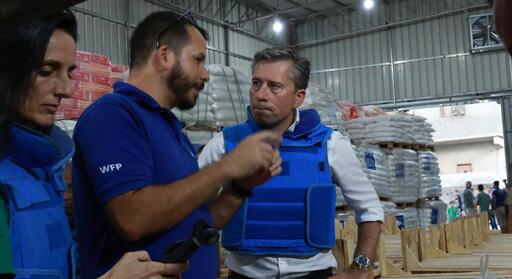The agency says it already has enough supplies in place to feed the entire population of the Strip for three months – if full access is granted by Israel.
One week into the fragile ceasefire, WFP has been bringing in an average of 560 tonnes of food each day.
“The ceasefire deal has opened a narrow window of opportunity, and WFP is moving very quickly to scale up food assistance and reach families who have endured months of blockade, displacement and hunger,” said Abeer Etefa, WFP Senior Regional Communications Officer and Spokesperson for the Middle East, North Africa and Eastern Europe.
Speaking to journalists in Geneva, Ms. Etefa said teams and supply networks were fully mobilised.
Five distribution points now open
“We’re still below what we need, but we’re getting there,” she noted. Five food distribution points are now operating across Gaza, focusing on women and children. “Our goal is to expand to 145 distribution points across all of Gaza—that’s the scale we’re aiming for,” she added.
Aid agencies stress that sustained access and multiple crossings are essential to reach everyone in need. Only two crossings are currently open, and those in the north remain closed, restricting deliveries to the hardest hit areas.
“Roads are blocked and destroyed. This is a huge limitation to transport,” Ms. Etefa said.
Because of access and security constraints, no food distributions have yet taken place in Gaza City, only nutrition supplies for children and pregnant or breastfeeding women.
Jens Laerke, spokesperson for the UN aid coordination office (OCHA), said the northern crossings remain closed “because the Israeli authorities have not opened them”.
He added that road repairs and clearance of unexploded ordnance are also essential for safety and access. “It is very important to have these openings in the north, as that is where the famine took hold,” he said.
Fletcher says UN determined to deliver
UN relief chief Tom Fletcher joined the aid effort in Gaza on Friday, saying humanitarian teams are delivering on a 60-day plan to massively scale up life-saving work.
He said though the challenges ahead are immense, the UN is determined to deliver on the humanitarian possibilities created by US President Donald Trump’s peace deal.
The Humanitarian Affairs chief drove to Deir al Balah, where he visited the Castle Bakery - one of nine that the World Food Programme (WFP) supports across southern and central Gaza.
UN Spokesperson Stéphane Dujarric said the ceasefire has meant that the bakery can access fuel and flour, allowing it to produce up to 300,000 loaves of pita bread per day.
170,000-tonne aid scale up
According to WFP, 57,000 tonnes of food are already pre-positioned in Egypt, Jordan and inside Israel, with plans to scale up to 170,000 tonnes – enough for 1.6 million people over three months. “Beyond that, we need to maintain at least three months of stocks at all times,” Ms. Etefa said.
On 16 October, 950 trucks entered Gaza, including eight carrying fuel and three carrying gas, according to OCHA. Around of third of them passed through UN-coordinated mechanisms.
UN Women: Recovery must be led by women and girls
UN Women’s Chief of Humanitarian Action, Sofia Calltorp, urged the international community on Friday to turn Gaza’s fragile ceasefire into a recovery led by women and girls.
“We have heard from so many women and girls across Gaza since the ceasefire began – a mix of fragile hope, deep exhaustion and quiet strength,” she said.
“For the first time in months, some can seek care, receive aid and sleep without the sound of airstrikes. But hope, on its own, is not enough.”
Ms. Calltorp stressed that over one million women and girls need food aid and a quarter of a million require urgent nutrition support. “This ceasefire is our window to deliver fast, to stop famine where it has begun and prevent it where it looms,” she said.
Serious question: if drones can be utelized for atrocities, why can’t they be for humanitarian reasons?
They could but the technology is not the problem, Isresl restricting aid is the problem. Its way easier to stop blocking a road than it is to start using drones, the issue is simply that Isreal will not let them eat. We could teleport the food to gaza and Isreal would find a way to use it as bait to kill people.
Explosives for one target are much lighter than food for millions of people.
However, drones don’t have to be expendable and food for a single family for a day could be carried in the same weight profile as a 155mm shell, which are carried regularly.
Seems like a decent project for Boston Dynamics, since they won’t do weapons - drones that can pickup, dropoff, return and charge without much user input.
Israel nor Hamas can stop food being dropped everywhere.
Never thought of that. My guess would be Israel would shoot them down or that they couldn’t carry enough supplies.
Explosives are far more energy-dense than food, but they are not edible.
Make sure they’re fed before killing them.





